new posts in all blogs
Viewing: Blog Posts Tagged with: Track, Most Recent at Top [Help]
Results 1 - 19 of 19
How to use this Page
You are viewing the most recent posts tagged with the words: Track in the JacketFlap blog reader. What is a tag? Think of a tag as a keyword or category label. Tags can both help you find posts on JacketFlap.com as well as provide an easy way for you to "remember" and classify posts for later recall. Try adding a tag yourself by clicking "Add a tag" below a post's header. Scroll down through the list of Recent Posts in the left column and click on a post title that sounds interesting. You can view all posts from a specific blog by clicking the Blog name in the right column, or you can click a 'More Posts from this Blog' link in any individual post.

By:
vschneider46,
on 8/29/2016
Blog:
The Open Book
(
Login to Add to MyJacketFlap)
JacketFlap tags:
Native American,
book activities,
Track,
Jim Thorpe's Bright Path,
Jim Thorpe,
Educator Resources,
Football,
Uncategorized,
Sports,
biography,
Joseph Bruchac,
Olympics,
Add a tag
 LEE & LOW BOOKS celebrates its 25th anniversary this year and to recognize how far the company has come, we are featuring one title a week to see how it is being used in classrooms today as well, as hear from the authors and illustrators.
LEE & LOW BOOKS celebrates its 25th anniversary this year and to recognize how far the company has come, we are featuring one title a week to see how it is being used in classrooms today as well, as hear from the authors and illustrators.
Today, we are celebrating Jim Thorpe’s Bright Path, an inspirational story for children of all backgrounds. A biography of the legendary Native American Jim Thorpe (1888–1953), voted the Greatest Football Player and Greatest Athlete of the Half-Century by two AP polls, focusing on his early childhood and how school and sports shaped his future.
Featured title: Jim Thorpe’s Bright Path
Author: Joseph Bruchac
Illustrator: S.D. Nelson
Synopsis: The biography of the legendary Native American, Jim Thorpe (1888–1953), focusing on his early childhood and how school and sports shaped his future.
of the legendary Native American, Jim Thorpe (1888–1953), focusing on his early childhood and how school and sports shaped his future.
From the day he was born, Jim Thorpe’s parents knew he was special. As the light shone on the road to the family’s cabin, his mother gave Jim another name — Wa-tho-huck — “Bright Path.”
Jim’s athletic skills were evident early on, as he played outdoors and hunted with his father and twin brother. When the boys were sent to Indian boarding school, Jim struggled in academics but excelled in sports. Jim moved from school to school over the years, overcoming family tragedies, until his athletic genius was recognized by Coach Pop Warner at the Carlisle Indian School.
Awards and Honors:
- Carter G. Woodson Book Award Honor, National Council for Social Studies
- Choices, Cooperative Children’s Book Center (CCBC)
- Teachers’ Choices, International Reading Association (IRA)
- Best of the Best List, Chicago Public Library, Children & YA Services
- Storytelling World Resource Award, Storytelling World magazine
Check out this interview with author, Joseph Bruchac, about Native American literature.
Resources for teaching with Jim Thorpe’s Bright Path:

Discover other books like Jim Thorpe’s Bright Path with the Joseph Bruchac Collection!
Book Activities:
- Draw attention to the use of similes in the book. For example: Jim took to it all like a catfish takes to a creek. It made him (Jim) feel like a fox caught in an iron trap. Epidemics of influenza swept through like prairie fires. Have students try to write their own similes for other events or actions in the story.
- Ask students to explore the National Track & Field Hall of Fame (www.usatf.org ) or the Pro Football Hall of Fame (www.profootballhof.com ) and plan an imaginary trip there or enjoy a visual visit on the Web.
Have you used Jim Thorpe’s Bright Path? Let us know!
Celebrate with us! Check out our 25 Years Anniversary Collection
 Veronica has a degree from Mount Saint Mary College and joined LEE & LOW in the fall of 2014. She has a background in education and holds a New York State childhood education (1-6) and students with disabilities (1-6) certification. When she’s not wandering around New York City, you can find her hiking with her dog Milo in her hometown in the Hudson Valley, NY.
Veronica has a degree from Mount Saint Mary College and joined LEE & LOW in the fall of 2014. She has a background in education and holds a New York State childhood education (1-6) and students with disabilities (1-6) certification. When she’s not wandering around New York City, you can find her hiking with her dog Milo in her hometown in the Hudson Valley, NY.
.jpeg?picon=3498)
By: Cait,
on 12/4/2014
Blog:
Cait's Write...
(
Login to Add to MyJacketFlap)
JacketFlap tags:
off season training,
tips,
running,
motivation,
art,
goals,
training,
track,
races,
Add a tag
When you close your eyes, may you dream of lanes, miles, and splits.

It’s never too early to dream of track, or any running goals for that matter. But at a time in the season where your next race may night be quite close enough to ‘taste’…the motivation to brave the elements (Hello, Winter, I was over you last month.) can wane for some runners.
I often take the snarky, or sarcastic, side to life, even when it comes to a ‘kind’ kick in the right direction. Here are some ways I suggest keeping yourself consistent until it IS close enough to ‘taste’ your next race.
1) That Runner Guilt Factor: I’ll be totally honest, this is usually my BEST way to combat a motivation lull. I remind myself that skipping a run usually is not worth feeling that ‘runner guilt’ later. No joke, you know it’s not fun going to bed tossing and turning because you caved to an instance of laziness.
2) The Endorphin Factor: Close to the above, I also remind myself that even if I feel tired/sluggish and the last thing I want to do is run…that usually changes after the first 5 minutes or mile. Once you get into the run those endorphins kick in, and I’ve never finished and thought, “Wow, I really wish I woulda just kicked it on the couch.”
3) Play Antagonizer: Mental dialogue, “C’mon, don’t be a weenie. Suck it the heck up, lace it up.”
4) The Buddy System: When in doubt, call a friend, arrange a run, join a group, social media that you ARE going for a run. That way if you back out, you’ve got to deal with the ‘Tweet of shame’ later. Good peer pressure and all that jazz.
5) Training Program: If you’re training to PR, I have to say I honestly recommend you have a coach, or are knowledgeable enough yourself to coach yourself. But self coaching is HARD…and it’s a lot easier to not have to ‘think’ about your training. That way, you have someone to tell you what to do, BAM, your job is just to run. Trust me, running is hard business, taking some things off your plate is nice. Plus, if your coach gives you the workout, no arguments, lace it up, Buddy!
6) Dream of Goals: Even if race day IS far away, write it down and know your goals. Like the picture above, if you VISUALIZE what you want and put it OUT THERE, it makes things feel more ‘real’ and you know what you’re working towards. It’s harder to blow off a written goal, one you dream about, right? Methinks yes.

7) Bribery: It’ll get you everywhere. Bribe yourself with new running gear, think about dessert, splurge on some cool new shoes, dream of pancakes on your run, create a cool playlist…whatever. When it doubt, donut it out…you just have to run first. 
8) Identity: Okay, some people may be all judgmental and say you shouldn’t DEFINE yourself as a runner…but I’ll be honest, a big part of who I am (or at least the parts I tend to like the most! haha) is that I’m a runner. It’s not just a passion of mine, but it’s a way I connect with people, my friends, and a mentality. I know if I’ve run for the day I feel better and am a happier individual. So race or no race, get my miles on.
9) Money in the Bank: Think of all these miles and workouts as money in the bank. The stronger you are going into the ‘meat’ of the season the better you’ll race. Doesn’t that sound logical? Picture your competitors, who do you think will do better come race day, the ones gettin’ ‘er did, or the sofa’ing ‘er did? The uglier the day/workout, the more excited you should be when you tackle it…it’s making you that much tougher.
10) Superiority: Remember that runners are just better. So go run, don’t you want to be part of the cool kids? 
Snark, goals, tough love to yourself…whatever it takes. Dream of miles, and remember you HAVE the support of the entire (awesome) runner community to give you a motivation boost when you need it.

.jpeg?picon=3498)
By: Cait,
on 9/16/2014
Blog:
Cait's Write...
(
Login to Add to MyJacketFlap)
JacketFlap tags:
running,
comics,
Cartoons,
motivation,
art,
drawing,
celebs,
track,
running shirts,
running clothes,
Add a tag
Last week may have been New York Fashion Week, but the 2014 track season was Maggie Vessey’s Fashion statement.

No need to say more.
Vessey took the opportunity of being a ‘free agent’ to prove she’s got the creative talents to match her performance prowess on the track.
“I do want to draw attention to the sport and maybe give people who aren’t necessarily interested in track and field a reason to be interested,” Vessey told Runner’s World. “But it is a very authentic expression of who I am, and I now have this opportunity to be able to put that out there, be bold, and take a risk.”
To all those eating her fashionably savvy dust, heed the words: look good, feel good. 
——-
Related:
Excellent read on Maggie Vessey in New York Magazine
Oiselle was representing runners at New York Fashion Week, I caught up with Founder and CEO, Sally Bergesen
My story on Kate Grace, professional runner for Oiselle.
Runner Fashion is All the Rage: Legs to Crush a Runway
My own (expanding) line of running apparel: Ezzere

I live in California so even though June 21st is ‘officially’ the first day of summer, I’ve been running in a hot box for weeks already. Never fail, during some of my summer runs I always get that Bush song, “Speed kills…” stuck in my head but I swap out the word to “heat kills”. #truth
Running when the brutal sun is scorching you isn’t my favorite thing. But until we find that perfect seasonless runner utopia we must deal. For those runners in humid states, good lordy I’ve spent some time running in those conditions and had to come back and wrench out my running shorts and sports bra, easily a couple cups of sweat there! haha.
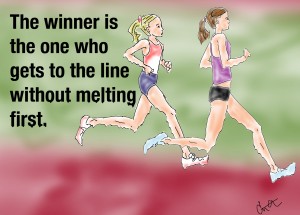
So here’s my running summer warning and tip round-up:
* Beat the Heat:
If you can, it seems like a no-brainer to try and get up and go run before the sun and temps are up, or wait until the later evening.
* Acclimate: Here is where you SHOULD actually force your runner butt to run in the heat. If you’re going to be racing under sweltering conditions you NEED to start getting your body used to running in the same conditions. The first runs, and especially hard workouts, are going to not feel all too pleasant. But eventually your body will start to adjust…you do NOT want the first time you go out and run in hot/humid/both conditions to be on race day when you’ve been doing all of your training at 5am to beat the heat. It’ll be like a body slam sucker-punch on race day.
* Hydrate…they hydrate some more: I’ve done some posts
HERE and
HERE all about hydration. But this needs to be BEATEN into your HEAD here. Hydrate religiously throughout the entire day!! You should be peeing darn near clear, by the time you feel thirsty you’re mildly dehydrated. Also make sure to get those electrolytes replenished as well.
* GI Issues: It’s no coincidence that your tummy may become more upset when the temps rise. I did a post
HERE explaining just how much dehydration can be the root cause of lots of running GI disasters. So another reason to stay hydrated…ooor, just go poop your pants…your choice.

Now let’s talk about doing hard workouts and races in the summer scorchers:
* Easy Does It: We already know that going out too fast can be the kiss of death. Doing that in the heat is like putting yourself through Dante’s extra levels of h*ll. You might feel okay at the start but it’ll come slap you hard in the body/face/legs later. This is where you should be running for EFFORT and not times…the heat and humidity are two big factors that slow down times. So adjust your paces accordingly and the power of negative splitting is much friendlier than the brutal kick your butt punishment of going out too fast.
* H2O Cool: If you’re at the track, bring extra water to douse your head and body between reps. Obviously keep some to take sips on, but getting that body temp down the hose-to-head method works well too.
* Seek Shade: Ahhh-duh. If you can find shadier trails to do tempo or fartlek runs on then it’s a no-brainer (vs. an uncovered track). But I also wanted to add this one in here meaning that if you’re doing a track meet and are doubling/tripling/etc. get you butt in the shade as much as possible. No need to have extra energy zapped out of you lingering in the sun unnecessarily.
Whew…and after that, just dream of ice cream and guzzling the entire river once you’ve finished the run. 
1) What’s one of your summer running tips?
2) How bad are you tan lines?
I could blind you from 10 miles away. 

Because how could they NOT stop and gawk at such a well-dressed runnerchick.  #Ezzere Baby!
#Ezzere Baby!

———
This short video hit my Instagram feed first…be sure to follow me there so you’ll be the first to see when new artage and such get dropped. 
Mosey over the BUY YOUR Ezzere Peacock Runner Tee…or any of the others. 
———

.jpeg?picon=3498)
By: Cait,
on 6/1/2014
Blog:
Cait's Write...
(
Login to Add to MyJacketFlap)
JacketFlap tags:
running,
writing,
motivation,
art,
goals,
track,
facing fears,
Sunday Morning Inspiration,
sunday morning motivation,
Add a tag
Strip away the muscles, the sinew, the bones
The flesh.
Alone with yourself.
in your mind.
A step echoing amidst chatter
doubts.Refutes.
I am stronger than you say.
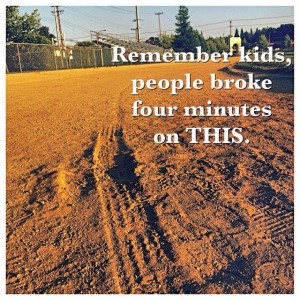
Tissues beg for slack,
plead for mercy.
I want to stop.
But I do not.
Mind runs on.
Push forward against protest
myself and my mind.
Friend, nemesis, untrustworthy deceivers.
I must stop.
You may not.
Only one step more.
LIAR!
——-
The June issue of Competitor magazine features Meb Keflezighi on the cover, the story is excellent and I urge you all to read it HERE. Not all can race outside of themselves, but it’s the quest to continually push our own limits that every runner is in a similar battle. Keep rising to the occasion.
More posts on MOTIVATION
——-

.jpeg?picon=3498)
By: Cait,
on 5/24/2014
Blog:
Cait's Write...
(
Login to Add to MyJacketFlap)
JacketFlap tags:
tips,
running,
videos,
goals,
training,
track,
exercises,
races,
workouts,
race tips,
Add a tag
Everyone wants to run faster, right? Part of getting faster is of course doing the shorter repeats; one must build that explosive power of course. BUT, there’s another part to getting faster and it’s training your BRAIN and nervous system to respond at a quicker rate.
A runner can’t utilize that explosive power to run faster without the nerve and synapse networks first being created to ‘tell’ your foot to move faster off the ground. Isn’t science and the brain cool?
The neuromuscular part of training isn’t something every runner is aware of, but if you’re not addressing it you can run all the 200′s in the world and not really be tapping into your full potential. I’ve written a few articles about the neuromuscular training and how it relates to runners:
* The Multi-Level Approach to Getting Faster
* Work on Getting Faster in Tri-Fecta Form
One of the exercises I mention are ‘Quick Feet Box Taps’. I got an email from someone who wasn’t quite sure if they were doing them right so I decided to make a little video.
You can also find it on my Instagram page. Start with a set of 15-30 seconds and see how many taps you can get. REMEMBER it’s QUALITY over quantity. If you’re getting slopping you’re going to start reinforcing bad habits and that will defeat the purpose. Work up to two sets and do the 3 times a week…preferably as part of your dynamic warm-up routine before workouts or immediately following the workout. It can be fun to watch yourself improve with more taps every week…you know us runners and that competitive spirit.  But again, quality over quantity…so if you have to start slow that’s what you need to do!
But again, quality over quantity…so if you have to start slow that’s what you need to do!
What, you love my shirt too?! Well, thanks…it’s my Ezzere Runner Face Tee! 
Happy Saturday my runner friends. Get those feet firing off the ground, coupling neuromuscular training and speedwork, and watch your PR’s get faster! 

.jpeg?picon=3498)
By: Cait,
on 5/22/2014
Blog:
Cait's Write...
(
Login to Add to MyJacketFlap)
JacketFlap tags:
track,
races,
race tips,
tips,
marathon,
running,
motivation,
goals,
training,
Add a tag
For runners, finding that perfect taper and method to peak right sure can be difficult! Which sounds kinda crazy because taking the taper at face value, one could think, “Well, I just need to cut back. I’ve done all the work, so let’s just coast on until race day and wind up with fresh as daisy legs!”
WRONG. Any runner can tell you tapering is a bit of a beast. Sometimes your legs do feel an extra bounce, other times they start feeling like dead weights and you start to freak out, “What the heck, why am I trucking bricks?!”

Some runners even build a little superstition around it, “The worse my legs feel on the warm-up the better they feel in the race.’ Not going to lie, I’ve experienced that one and can back the logic.
So let’s talk taper. We’ll even start from the most basic of basics up.
What is a taper? Training is done in phases, working backwards from the date of your big race. The closer you draw to your race, the more the goal of workouts shift from ‘building fitness’ to ‘sharpening’ and ‘honing’. A week before your race you’re not going to be able to increase fitness anymore, that work’s been done, so it’s a matter of maintaining fitness and then reducing the volume so your legs feel fresh come race day. [Tapering can be done anywhere from 1-3 weeks before your race, depending on distance and all that good stuff.]
Logistics: Runners who are tapering will cut their overall miles back, the volume of workouts decrease, and you’ll see workouts like 200′s, 400′s, or for marathoners, maybe a few longer repeats (ie: miles) at race pace. Just getting the wheels turning.

Common Mistakes:
1) Not decreasing enough:
If you’ve been training at 110 miles per week and your ‘taper’ is cutting down to 100 miles per week that’s really not going to leave you feeling all that fresh, right? Same goes with pushing your ‘taper’ workouts too much; grinding out your best 6xmile four days before your race day isn’t doing you any favors.
2) Decreasing too much: So the runners who think, oh I’ll just go from 110 miles down to 20 and I’ll feel GOLDEN! Wrong-zo. The body has a crazy way of adapting to us crazy runners and doing what we do. Dramatic shifts, the body doesn’t like that at all. Go too far from one extreme to the other and your body will be like, “wtf is going on?!” In the case of the runner above, they’ll actually be feeling sluggish because their body is used to much more stress. It actually NEEDS more miles to feel better. Crazy, huh? But kinda cool too.
Bottom line: There’s no perfect amount for everyone, it comes back to what works for you and your race distance. But a nice rule is that when tapering your mileage should be reduced by 20-25% of your average training volume.
3) Pre-Race Day Off: Many runners like to take the day before their race completely off. I would like to argue that, they should instead take the day TWO days prior to their race off. Why? Sometimes your legs will feel stale after a complete rest day, it’s better to do a short shake-out run and strides the day before to ‘bust out the rust and creaks.’ You still get a day off, but going into the race you’re not ‘creaky’. This is also why if you’re running a night race, lots of runners like to do a short (10-15min) shake-out run that morning.
4) No Speed-work: Taper logic might seem like you shouldn’t do anything hard…go into the whole week totally fresh and rested. Refer back to number 2 and realize that once your body has become accustomed to a certain degree of work (ie: stress) it needs the stimulus. Going 4-plus days without any faster turn-over will leave your legs feeling sluggish and slow. For races 10k and below, a good workout to do three days before your race is 8x200m with 200meter recovery. Any way you slice it, you still want some ‘sharp’ quality sessions leading up to your race.
Tapering is a tricky science, that’s why I firmly believe runners should have a coach they trust to do the sciencey planning stuff. Then the runner isn’t left ‘thinking’ all this out. Planning and wondering “is this workout right? Is this what I should do?” can get in the way of your workouts, and it can be liberating to give that ‘stress’ to someone else who KNOWS their stuff.
That way, runners can just turn their brain off and stick to what they love to do…run. Hey, running the workouts are hard enough, no reason to add more thinking than necessary to the mix. 
———-
More posts on RACE TIPS
More posts on PRE-RACE CONFIDENCE
Make sure you’re looking GOOD doing all that training…Ezzere’s got your back there! 

———

.jpeg?picon=3498)
By: Cait,
on 5/8/2014
Blog:
Cait's Write...
(
Login to Add to MyJacketFlap)
JacketFlap tags:
races,
race tips,
tips,
running,
training,
track,
motivation,
goals,
nutrition,
Add a tag
Now my younger brother’s first love is rugby, second is football, but for the three weeks between seasons he decided to do track! Wahoo…I was stoked!! I’m also in awe of the fact that he doesn’t do any speed-work and then just blitzes those 400′s and 200′s like they’re nothing.

The mystery is solved as to where all of the fast twitch muscle fiber genes in the family went. Clearly all were saved and concentrated into the youngest Chock sibling. Oh and I guess he stole my coordination genes too. 
Granted he’s got the competitiveness of a Chock, so he’ll gut out a race and pay the price after to hit those marks. But the truth is that last 100 of a 400 isn’t fun for anybody, no matter if you’ve trained or not…BLECH…talk about booty lock.
Checking out those high school meets has been fun, observing just as much so, and here are a few tips I’d pass on if teenagers actually cared to listen to us old folks:
* Warm-up and Recovery:
set yourself up to run your best, not warming up before a race is setting yourself up for
both injury and running below your maximum potential. Cold muscles no likey sprinting. The same for after your race, do all you can to recover so you can come back stronger. That includes a cool-down and
refueling within 30 minutes of finishing.
* Drafting and Tangents: it was windy at the track meet and those are days where you really want to draft. Leading expends more mental energy and on windy days it expends a heck of a lot more physical energy to lead. If you can, tuck in behind somebody until you’re really to surge past them. When you DO make your move, try to make it on a straight away…running the tangents on a race course is the same idea, don’t run more than your race distance or your competitors are.

* When You Pass, You PASS: racing is mental like that, when you make a move and pass someone you want to be passing them for good. Conserve energy and then blow by that sucker! Don’t ‘weakly’ pass them because then they can just tuck in behind you and let you do the work. You want to BLOW by them and try to mentally break them. Make them think, “Dang, they’re feeling much stronger than me, I can’t keep up.” Even if you feel like crap, it’s a race, you should feel tired, but your competitors don’t have to know you’re tired as heck and clinging on until the finish line. Break them and leave them in your dust.
* Cling-on: sorry, no sci-fi reference, but this speaks to those getting passed. Read above. You can’t get in the mind of your competitors and chances are they’re working, tired, and hurting too. If they pass you, rally the troops and try to stay with them. Don’t let THEM mentally break you. See, it works two ways like that. 
The last thing I’ll add, while I like to joke that I have not a single fast twitch muscle in my body (I’ve never been biopsied, but I’ll say I probably only do have one!) DON’T use that as an excuse to avoid speed-work. It’s incredible how much you can manipulate and overcome your natural predisposition in terms of speedster versus endurance maven. You’d be surprised that, yes, even ye of one speed can get some wheels on themselves and wind up with really strong kicks.
The thing is you just have to train those muscles! For speed you need to build power (hills, sprints, plyo’s) and all that good stuff is plenty of fodder for another post!
Get out there and kick some butt…embrace the booty lock too! 
——–
Have you checked out my Ezzere Running Tees yet?? Mosey over, folks!!
Send MAJOR cheers to one awesome Kim @ Day with KT this rockstar runnerchick and mom is out to kill it at her 50 mile race this Saturday!! WAHOOOO!!!

So one very hot singer has crooned, “Speed kills…” Well any runner can tell you that one! It’s a little two-fold though, speed kills your opponent and if you consider the lactic acid factor it probably feels like you’re killing yourself too!  Remember THIS cartoon??
Remember THIS cartoon??
It’s true, us distance runners, of the slow-twitch muscle fiber realm would most likely opt for a 10 mile tempo than sets of 800′s or 200′s. Distance logic right there.

The thing is though, while you can’t inject your distance running legs with fast-twitch muscle fibers you CAN hone the ones you’ve got and it’s quite remarkable how malleable that muscle make-up can be with proper training. But here’s the thing, for long distance runners, GETTING FASTER takes both a physical and mental component.
Physical
I’ve written a few articles on the specific physical training tips to run faster. Distance runners SHOULD embrace those horrid 200 repeats, choke down those shorter intervals because speed translates up. You need to reverse ‘common’ distance logic and build from the bottom (aka shorter distances) up.
The faster you can sprint, the faster you can comfortably hold a ‘slower’ pace and longer. That reads as faster 5k’s, 10k’s, and marathons.
Do those shorter intervals, add some hill sprints, anything that involves explosive power. That’s the muscle-building and training factor.
Mental
Here’s the thing, if you’re like me you HATE that short running stuff because you ‘feel’ like you suck at it. You feel out of your element and get stressed more for the short stuff because it feels awkward, doesn’t come naturally, and thus gets a little frustrating.
ALL those thoughts create is PHYSICALLY impossible to run your best sprints. Crazy how the MIND can once again stop you from being the best runner you can be. The thoughts of feeling ‘out of your element’ create a foundation for stress and rather than running RELAXED as you should, you’re running tense. Ironically the more you ‘try’ to run faster, the slower you’ll be. True fact.
Learning and reminding yourself to run relaxed is an ongoing process. Here are some mental thoughts that can help you stay relaxed and allow your body to run faster:
* Arms: Laws of running physics (?? lol) hold that your legs can only move as fast as your arms. I like this because rather than think about your legs (let’s be honest they’re hurting like mad, let’s NOT think about them at all to block out that pain!) I think of moving my arms front-to-back as quickly as possible. The legs will follow.

* Eff It: This is the mentality I’ve adopted during short intervals, but let me explain. I KNOW ‘trying’ to run faster will shoot me in the foot, so I force my type-A brain to do the opposite. I remind myself, “Don’t worry about the times, I know speed isn’t my strong point, but it will only improve if I work on it. So eff it, relax, you can’t FORCE anything so just roll with it.” Basically you have to embrace the ‘awkward feeling’, loosen up, and just ‘have fun’ with it. Also, stop telling yourself that you suck at the shorter intervals! 
* Effort: Tying to my tip above, ultimately running and training comes back to perceived effort. The watch and numbers only tell part of the story, so another thing I tell myself is, “Just run hard.” Run faster and even if you don’t look at your watch (this can help runners if they have built themselves a little speed phobia) if you’re running HARDER and FASTER you’ll get the rewards.
Bottom line here: even distance runners NEED speedwork if they want to run their longer races faster. Embrace the nasty shorter intervals, adopt the ‘eff it attitude’ and stop FORCING it. Relax the heck up and in true ironic distance logic you’ll run faster when you’re ‘trying’ less. 
1) Speedwork, love it or hate it?
2) When is the last time you did speedwork?
3) What’s something you tell yourself to make sure you’re running relaxed?

Please clear the track, we’ve got some runners coming through, and they’re taking care of business!!

Running is not a sport for the excuse-makers of the world. It takes lots of motivation and dedication to improve, but the glorious thing about that is the power to get better is RIGHT there, in your hands (eeerr…feet?), and within your control.
In a sport where work ethic is more important than your height, shoe size, or inborn talent, the mentally tough, refuse-to-give up runners are the ones who come out on top. And after all, it’s watching those kind of runners overcome obstacles and odds that in turn inspires US to follow our own goals. Dream bigger than our running shoes and put in the work.
*Cue the African Safari Music* “It’s the circle of runner-life.” *Bamboo lifts your racing shoes to the heavens above.*
Running is also a state of mind. It’s mental. I’ve had people call me a jogger, and I joke about being heinously offended. Then I’ve had people be offended that I’m offended about the j-word. Like I’m a runner ‘snob’ or sometimes people feel judged saying, “I’m not a runner, I’m not fast enough to be a runner.”
In both of those instances, my reply is the same:
* The difference between a runner and a jogger ISN’T pace, mileage, or numbers related.
* Earning ‘runner’ status is in the mind, the spirit, the dedication.
You’re a runner if you LOVE it.
You’re a jogger if you feel ‘forced into it’, like it’s a chore, or you’re only doing this to lose weight.
Runners are self-motivated and if anything have to have someone else beat/talk ‘sense’ into us at times, to hold us back, learn the times when not to run.
Joggers aren’t all that worried about skipping days. They celebrate any ‘excuse’ not to go jogging.
Joggers aren’t hung up on injuries, again, “I hurt my toe…welp, I don’t have to go the gym!! YAY!!”
Runners go through mental torture and endorphin withdrawals. Injuries are about the closest to h*ll that we can get.
So you see, me NOT wanting to be called a jogger isn’t being a snob. It’s just that I know I’m a runner in spirit. And others, regardless of their pace or point in their running life journey thing, shouldn’t force the jogging title on themselves.
As a runner, you’re a runner. You know it. You can’t lose your running license during injuries or setbacks.
You’re only NOT a runner the day you decide to stop. Until then, keep on running, My Friends!
1) What is one of your criterium for being a runner?
2) Do you get offended being called a jogger?
3) Do you care either which way at all? hehe.

Racing is a fierce sport. Take no prisoners. Competition.
Racing is
thrilling
spine-tingling
adrenaline
pushing
pressing
competing.
Pain. fighting. lactic acid.
MENTAL TOUGHNESS

Running is a test. Against yourself. Your competitors are there to PUSH you to your best.
Competition is a gift. THEY will elevate you, take you places you didn’t think you could go. PUSH you past pain thresholds your mind told you you’d never go.
Racing is fierce. It’s better than a blood sport, it’s a game of wills. You are the pawn, the King, the Queen, and dictator.
You control what the body puts out. Be fierce. Be strong.
Be a competitor.
You amped yet? Good luck to anyone and everyone racing this weekend…track season is always so freaking exciting! 
——–
NEVER fear your competition…they are there to help you. Read more…
Race day tips HERE
A little dark or serious today? More posts on MOTIVATION and CARTOONS 
——–
1) Finish these sentences: Race day is…
2) When I think of my competition, I…
3) I am in control of my race, I know I’ve put my best out there by…

Track season is coming…can you feel it?
There’s something special about stepping on the track. There’s a little tingling that starts in your spine, if you’re a runner you can’t stop it. The hairs on your arms start to prick, the back of your neck feels a chill. It’s unconscious, your body senses the speed. The excitement.

Even when I’m flying and we’re close enough to still see the ground, whenever I visibly make out the wide oval of a track I smile. I feel like it’s the Universe’s way of saying, “Hello!” just to me, it’s a special message just for me…like it knows there is a runner on board. So spotting a track on a plane always feels like a good luck sign.
Every track has stories to tell. Years and years of secrets buried between the lanes. Stories of hope, dreams the red rubber can feel through the spikes. Underneath the rubber the gritty dirt holds lasting memories from runners decades ago.
The track feels, but it is an unbiased judge, cold at times, but it has to be. It can’t make everyone a winner, it can grant EVERY runner their dreams, it couldn’t possibly fulfill every goal made by starry-eyed harriers. For every smile there may be tears, but that’s part of the magic. Part of the waking dream.
The track tests every runner, but when we make those goals, go to bed with those dreams, we know this. We go in fully aware that we could wind up smiling or falling short. That’s okay, we spike up anyways because that’s all part of the fun.
The journey TO the track is just as special as what transpires between the lanes.
1) Have you run track? Are you looking forward to track season coming up? What races?
2) Do you like track, roads, cross country, or trails more?
3) What’s one of your fondest track memories? Funny, inspiring, utter fail, anything!

Lately it feels like my brain is running way faster than my legs could ever keep pace. That’s a darn shame, because one would certainly opt for running a new PR rather than mentally shouting, “SHUT UP!” to your brain at 2am and imploring it to go to bed. 
Speaking of PR’s, track racing season is getting to be in full swing. Some people have a bit of a phobia when it comes to the track, others find the monotony of double-digit laps, well, monotonous. The thing with track though, is it BLEEDS speed…as a runner, how can you not love that?

Each distance is unique, duh, the number of laps to the race you’ll be running presents its own challenges. The ratio of speed to endurance, the contrast between utter lactic ONSLAUGHT from the gun versus the more gradual building of the pain in the 10k. Both grueling, just in a different way.
Each race has a ‘volatile’ factor. This would be the crucial moments and laps that can make or break your race. The margins of time where if you’re not ON IT you may have very well lost the race even if you’re still got laps and laps to go.
There’s not just ONE moment in time of course, but for the sake of brevity let’s highlight a few of the volatile factors for the events:
* 1500/Mile: That dang third lap. Here is where the pain of the pace has already set in, the ‘taste’ of the finish isn’t quite close enough to kick in. Your mind starts to dauntingly anticipate that grueling last lap. COMBAT: Know that third lap is going to suck, know that it will make your race if you can pass the people letting their brain wander.
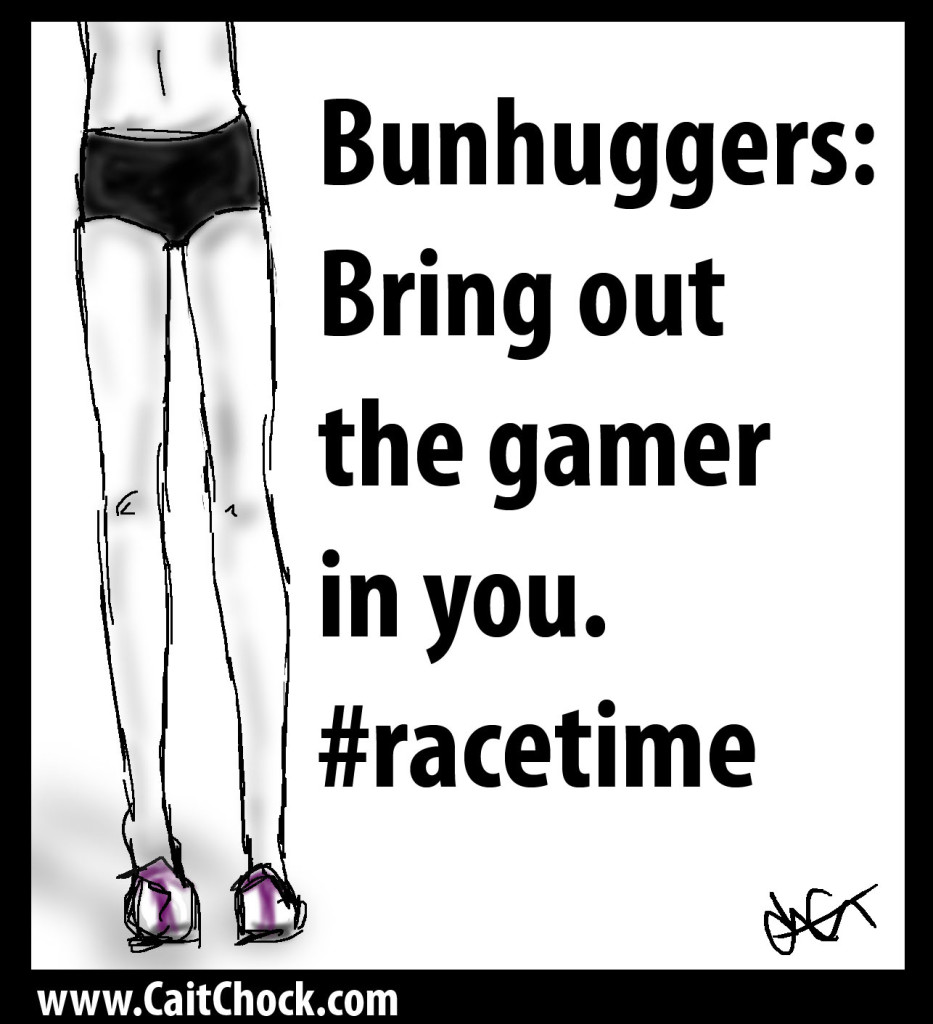
* 3200: Right around laps 4-6 it is easy to let your brain check-out. It’s prime time to make a move, surge and establish a gap on those who either went out too fast for that first mile or the poor souls who are just letting their mind wander. COMBAT: Go out on pace the first mile and throw down a move…remember the beauty of negative splits.
* 5k: It’s funny how running that first mile can feel so easy, a breeze, too easy. The middle mile is where you need to wrangle your brain and keep it FOCUSED. Much like the 3rd lap of the mile, the middle of your 5k can lapse into a fog if you’re not careful. COMBAT: Don’t let yourself get pulled out too fast the first mile, stay mentally engaged the middle mile, and anticipate the cold slap of pain somewhere after the second mile. It’s funny how it can suddenly sneak up on you, but be prepared for it and stay strong through to the finish.
Each race has its own set of ‘volatile’ factors…that’s what makes each and every track distance so fun. It’s a test, as is everything with running, testing mostly yourself. The competition is there as an opportunity to propel your performances forward…feed off of their presence.
Track is awesome, just don’t let the distance of the race pull a fast one on you. Be prepared and then enjoy the unique challenges of each event.
1) What is your favorite track distance to race?
2) Pick a distance I didn’t highlight and share one of their ‘volatile’ factors.
3) Share a ‘volatile’ factor that I didn’t address for one of the above races.


Find me a track runner who doesn’t have Lane One mindless pedestrian stories and I’ll show you a unicorn who poops gold.
There really needs to be more universal awareness for the word, “Track!” It seems pretty flipping clear to me, no? As it is, when you’re in the middle of a 5 mile tempo, gut-wrenching 400′s, or dare we even THINK about, a race…having to yell anything seems like a burden. We may say, “Track,” but you know we’re all thinking, “Look, A-hole, wise up and move the eff outta my way…I’m busting my @$$ and you’re walking a 15min mile…clear the heck out of LANE ONE!”

If you knew it wouldn’t ruin your split, you know all runners harbor the fantasy of dropping shoulder and just plowing through the oblivious idiot. For all of us who have fruitlessly, wished, go read Mo’s account of an epic Lane One throw-down. I’m only sorry it messed up the runners’ repeat.
I’m not heartless, okay, there have been days where little kiddies are weaving in and out of Lane One. I’m not anti-child, but I’m also not going to lie and say that when I’m running and already feel like I’m dying, I really don’t want to have to play Chicken with your child. Parents, please, do all us runners a favor and bolster their love of track in Lanes 6-8.
Teenagers who think you’re funny, cackling at us from the infield or on the bleachers ‘kickin’ it’ after school. You’re not funny. But to their credit if they are clear of the inside lanes, by all means go about your business. The world will offer you its slap of reality soon enough. Enjoy thinking you’re the coolest things to ever walk the planet. Or, come down and join us for some fun on the track…you would actually be cool if you helped pace, we’d love you forever!
What it really boils down to is this: I don’t care what language you speak, I don’t care if you worship a deity or the all-mighty Swoosh. You can be purple or polka dot, you can be in love with Cheetos or Pop-Tarts, you can be cool and have an addiction for running or find your sweat elsewhere.
I’m one of the least judgmental people in the world, but when someone yells, “Track,” you better move the he## outta Lane One.
1) What is your worst Lane One horror story?
No joke, middle of a 3k race and I was almost impaled by a javelin…girl was holding it and decided to stroll across the turn just as I was rounding it.
2) Do you typically yell something out if you need your path cleared when running, or not?
3) What is another rule of the track that needs to be better enforced or the masses need some schooling on?


Have you checked out these signs lately, it sure looks like runners all over are getting offered some pretty sweet deals?!

Watch out who you line up against at the track…nevermind, I’m sure you’ll be the one offering up the free butt kickings rather than the other way around.

Mud at the cross-country course is a given, but you decide whether the splattering will end up on your frontside or your backside. Same goes for all those trail runners.
But look-out for these hazard signs..don’t want to wind up in the Spit Zone when a rogue loogie flies your way.
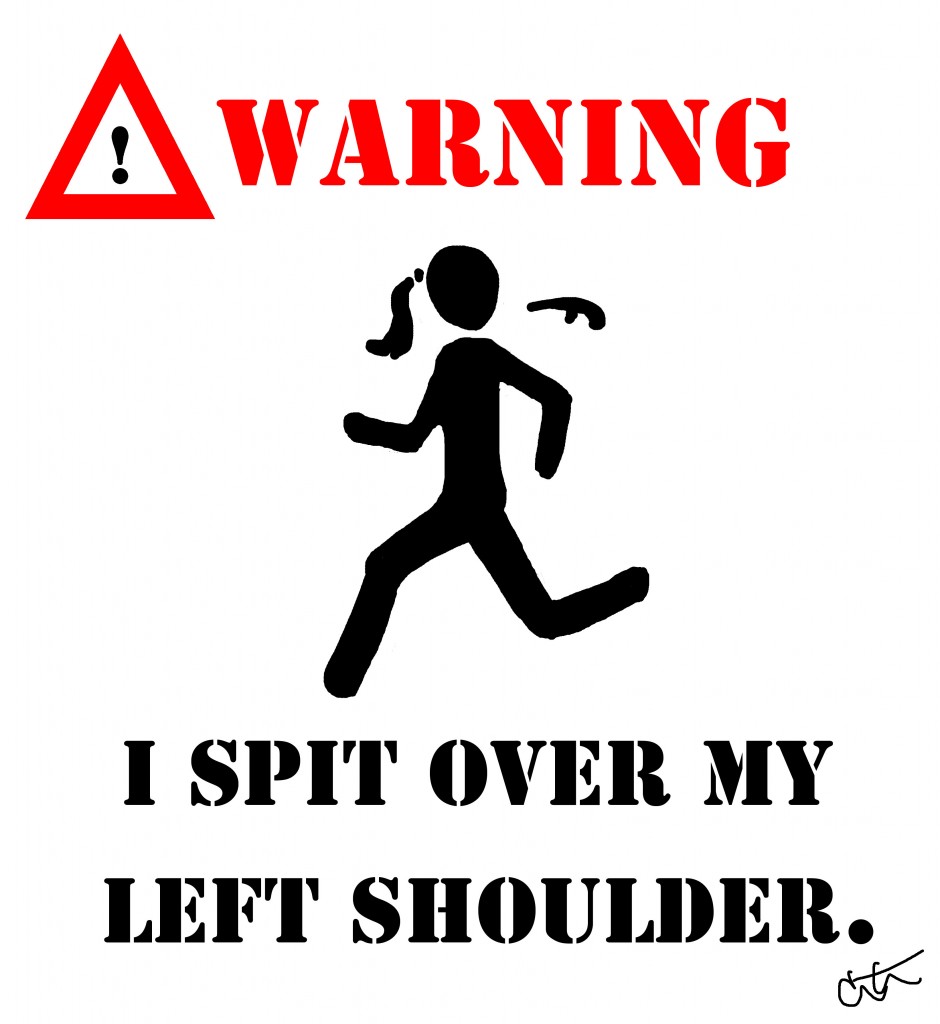
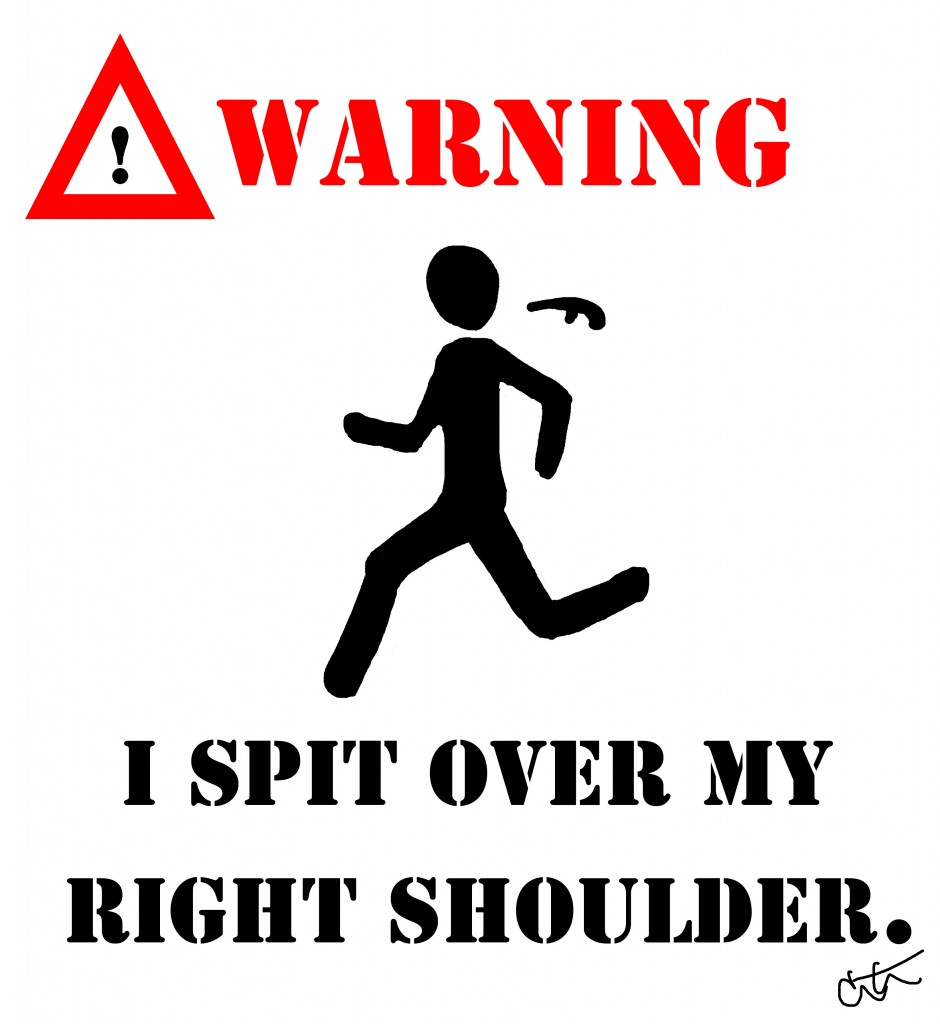
Stay safe and fast my runner peeps! 
1) Which do you prefer more, track or cross-country? Or are you more in favor of trail racing, road racing?
2) Spitting zone, which shoulder do you typically send them loogies over?
3) If you had a sign posted after your last run, what would it read?


The hazard zone of any run, every hard workout, each race is the middle. The excitement and adrenaline has worn off from the first mile and you’re not quite close enough to the finish line to taste it. Here-in lies the dead zone…the dead center.
WARNING: You are now entering the hazard zone. Enter at your own risk. Proceed with caution and ample amounts of guts.

We can break up each workout or race into three parts, to make things simple let’s take a 5k.
* Stage 1:
The first mile you’re running on adrenaline. It’s easy to get caught up and go too fast actually, and here is where it’s important to, if anything, stick to your race plan or goal paces
. Negative split running generally works best; if you feel like you can run below pace do it in the next stages.
* Stage 2 aka the Hazard Zone: Mile two is where fatigue sets in, the lactic acid has had a chance to build. Mentally it’s easy to let your mind wander or start to dwell on the fact that you’ve still got two miles to go.
* Stage 3: When you’re close enough to ‘taste’ the finish your mind can snap into focus and dig for an extra gear rather quickly. However, if you’ve dawdled away during Stage 2 and only reach this blast for home 400 meters from the finish you’ve lost time and if you cross the line with legs that were able to steamroll THAT much it’s most likely a sign you could have brought more to the race that day. Regret will set in moments after the finish line.
WARNING: The hazard zone is the biggest chunk of your race or workout. It takes up more than an equal third.
The thing is, taking this 5k example to a workout, say of 6×800 meters. The ‘novelty’ of Stage 1 could wear of after the first interval. Then it’s really only the very last interval that anyone can ‘gut’ through. So that leaves 4×800 meters of hazard zone.
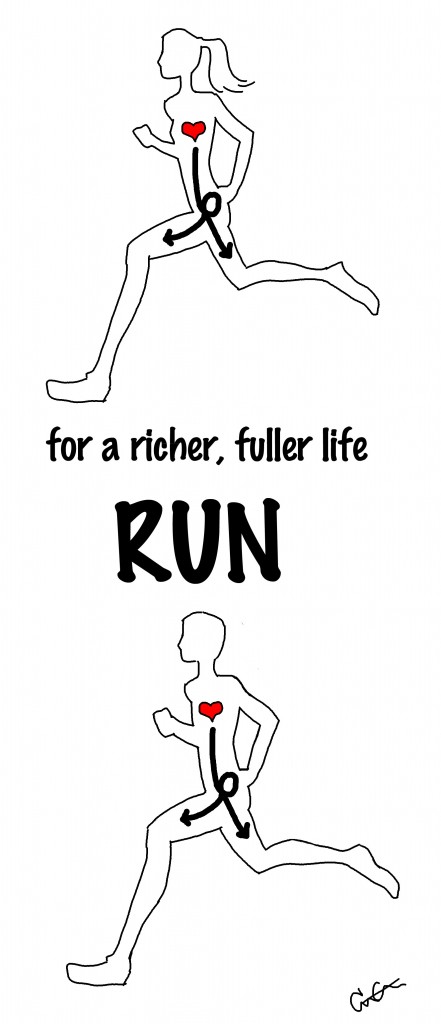
Your hazard zone runner care kit:
* Predict it:
Know the hazard zone and
be well aware it’s going to hit. Here is where before your workouts or races even happen you
can use visualization to get yourself mentally prepared to handle it.
* Prepare for it: There is mental preparation that you need to do before and during the workout. Having others around you for your hard workouts can also help, as they can pull you along. Physically you can also set yourself up best to push through the hazard zone by ensuring your legs have enough in the tank. This includes properly warming up to get your body ready to run fast and then being mature enough to run within yourself for the early intervals. If you blitz out too fast in the beginning, physically you could sabotage your work
If you’re watching the London Olympics like it’s an IV line then you’ll notice some familiar runners lining up for the heats of the 5k after their 10k finals a few days prior. I won’t prattle off all of them but amongst the doublers were Mo Farah, Galen Rupp, and Sally Kipyego. Sally Kipyego won the Silver Medal for the 10k and came back two days later to clock 15:01.87 in her qualifying run of the 5k.

Jaw-dropping times aside it brought to mind a topic that I wanted to discuss: running the days leading up to your own race. More specifically the day before race day. In a similar line of thinking to ‘saving their legs for the race’ and thus skipping a warm-up, newer (and not-so-new sometimes!) runners take a complete rest day the day before their race.
I can see their line of reasoning, but doing zilch the day before:
* Will actually leave you feeling a little stale the next day. If you’re consistent in your training, your legs are USED to doing something on a regular basis, and coming back off of nothing the next day will be a little ‘shock’ and your legs.
INSTEAD of doing nothing:
* 2 or 3 days out from race-day:
Make sure you do something with a little speed. Sometimes runners make the mistake of going over-board on the taper mode. Cut back your volume if the race is one you’ve been keying towards, but don’t go from 60 miles to 10 miles…you want to still keep your body attuned to the action of running. Similarly, don’t let an entire week prior to the race go by without doing something at, or faster than, race pace. You want to stay sharp so that come race day your legs will still ‘remember’ what if feels like to turn-over at the pace you want.
* Day before: Do a light shake-out run. Depending on your regular mileage and race distance this could be anywhere from 20-35 minutes. Go easy and then end with a couple fast strides, drills and lots of stretching.
* Race day: If you’re running in the afternoon or night it can be beneficial to also do a quick run in the morning to ‘flush out’ the system. Here, think 10-15 minutes…just enough to break a sweat and then stretching.

If you want to take a day off (and days off can be integral parts of a training program, know your body and know your volumes people!) it can actually work better to take that day off TWO days before the race. Ironic, yes, but the body is a crazy beast all it’s own. 
In getting back to the amazing Olympians…doubling is tough business, don’t get me wrong. Of course they have trained enough and with the goal of doubling in mind so they have prepared their body, and then in their mind know that second race they’ll probably have a little less pop that usual. However it proves my point in that you CAN run plenty well in a race without going into extreme-t

By: sylvandellpublishing,
on 11/29/2009
Blog:
Sylvan Dell Publishing's Blog
(
Login to Add to MyJacketFlap)
JacketFlap tags:
Teachable Moments,
hibernate,
hibernation,
migrate,
muskrats,
terrapins,
tundra swans,
winter,
animals,
migration,
moose,
eagles,
raccoons,
wolves,
sea turtles,
loons,
track,
humpback whales,
salmon,
Add a tag
As the weather turns cold and winter approaches, we add layers of clothes and turn up the heat. What do animals do to prepare for the cold?
Adapt:
Some animals prepare for cold weather by gathering food and storing it for the upcoming winter when it will be harder to find. Can you think of any animals that do this?
Other animals are able to find food through the winter and grow thicker layers of fur. Can you think of any animals that do this?
Hibernate:
Some animals go into a deep sleep over the winter. They usually will eat lots of food in the fall then go to sleep in a den or a deep burrow. A true hibernating animal’s breathing slows way down and its body temperature drops.
Some animals sleep heavily for long periods but will wake up every occasionally to eat.
Migrate:
Seeing birds flying south in the fall is common. They are not only flying to warmer climates for warmth but to be able to find food that is more readily available. They usually follow the same routes every year. Some animals learn the routes by following other animals (mother?) but other animals seem to know where to go by instinct. Scientists aren’t sure how the animals know how, when, or where to go.
Birds are not the only animals that migrate to warmer weather during their winters. Can you think of any other animals that go south for the winter? Do you know any people who go south for the winter? Where do they go?
Not all migrations have to do with warmer weather. Some animals migrate as part of their life cycle. Life cycle migrations may take place every year and similar animals may gather in special spots to find mates or to have babies.
Other animals might migrate only when giving birth or to lay eggs in a specific location (where they were hatched).
Websites of interest:
ParkWise (Alaska National Parks’ e-classroom): Migration: http://www.nps.gov/akso/parkwise/Students/ReferenceLibrary/general/MigrationBasics.htm
Tracking animals. Sometimes scientists put satellite collars on animals so they can track their movements. This helps us to understand how, where, and when animals move around the earth. Here are some sites where you can follow various animals:
WhaleNet: (tracks seals & whales) http://whale.wheelock.edu/whalenet-stuff/stop_cover.html
SeaTurtle.org: (tracks sea turtles) http://www.seaturtle.org/tagging/
Journey North: (tracks whooping cranes, hummingbirds, monarchs and other animals) http://www.learner.org/jnorth/
Alaska Seal Life Center: (tracks seals) http://www.alaskasealife.org/New/rehabilitation/index.php?page=rehab-tracking.php
Wild Tracks: (manatees) http://www.wildtracks.org/Florida/home.html
Ideas for experiential learning:
Keep a wildlife journal for one week. Identify what animals you see and what they are doing. Do you think they are getting ready for winter? Do you see any signs of animals even though you might not see the animals themselves?
• Bird feathers
• Chewed pinecones
• Chewed acorns or nuts
• Scat (droppings)
• Animal tracks
• Bones
What are some ways that humans prepare for cold weather? How do the clothes we wear change with the seasons? Why?
Do we eat any foods now that we might not eat during the hot summer? What foods and why?
In the book, Whistling Wings, the young tundra swan flies about 1,000 miles without stopping to rest or eat.
• Look at a map and figure out how far 1,000 miles is from where you live. Could you walk there without stopping to slee
 LEE & LOW BOOKS celebrates its 25th anniversary this year and to recognize how far the company has come, we are featuring one title a week to see how it is being used in classrooms today as well, as hear from the authors and illustrators.
LEE & LOW BOOKS celebrates its 25th anniversary this year and to recognize how far the company has come, we are featuring one title a week to see how it is being used in classrooms today as well, as hear from the authors and illustrators. of the legendary Native American, Jim Thorpe (1888–1953), focusing on his early childhood and how school and sports shaped his future.
of the legendary Native American, Jim Thorpe (1888–1953), focusing on his early childhood and how school and sports shaped his future. Veronica has a degree from Mount Saint Mary College and joined LEE & LOW in the fall of 2014. She has a background in education and holds a New York State childhood education (1-6) and students with disabilities (1-6) certification. When she’s not wandering around New York City, you can find her hiking with her dog Milo in her hometown in the Hudson Valley, NY.
Veronica has a degree from Mount Saint Mary College and joined LEE & LOW in the fall of 2014. She has a background in education and holds a New York State childhood education (1-6) and students with disabilities (1-6) certification. When she’s not wandering around New York City, you can find her hiking with her dog Milo in her hometown in the Hudson Valley, NY.






























